مرحبا بكم في قسم تكنولوجيا المعلومات في msentert.com
نظام معلومات المحرك
Author Mahamad Suleman Nadaf
Copyrighted material, not to modify and reproduce the material
Introduction
Structured systems design and structured systems analysis of Engine information system software. This article contains structure chart, data flow diagrams of EIS. Processed information about engine measurement and performance these include physical measurement that is geometrical dimension of engine such as cylinder diameter, length of piston stroke, cylinder volume and engine ratings such as efficiency, horsepower, compression ratio, heat balance sheet. Structure chart of EIS for a function-oriented design the design can be represented graphically by structure charts. The structure of a program is made up of the modules of that program to gather interconnections between modules. Every computer program has a structure it’s structure can be determined by the structure chart of a program is a graphic representation of it’s structure. In a structure chart module is represented by module name written in the box. The functional module of a system (Either the problem domain or the solution domain) can be represented by a Data flow diagram (DFD). Data flow-based modeling is often referred to as the structured analysis technique that uses function-based decomposition while modeling to problem. It focuses on the function performed in the problem domain and the data consumed and produced by these functions. It is a top-down refinement approach which was originally called structured analysis specification and was proposed for producing the specification. System designing includes module designing which are described in structure chart and data flow diagrams. Designing input this is data entry section this is concerned to logic of the program what data has to be entered in the input fields example engine number, no of cylinders, cylinder bore diameter etc. these are input fields. Designing output this section gives the computed results reports are part of the designing output section. The outputs are calculated results set of gathered sorted information reports graphs etc. EIS gives reports of engine measurement and performance such as geometrical dimensions, horsepower, efficiency, compression ratio and heat balance sheet.
تتعلق هذه الورقة الفنية ببرنامج نظام معلومات المحرك. يوضح كيفية استخدام منطق البرمجة لتطوير البرامج والصيغ الرياضية المستخدمة لأداء محرك الحوسبة. يعطي تصميم النظام الهيكلي وتحليل النظام الهيكلي لـ EIS وصفًا حول تصميم الأنظمة الهيكلية وتحليل الأنظمة الهيكلية لوحدات البرامج المستخدمة في البرنامج. البرنامج عبارة عن مجموعة من برامج الكمبيوتر. برامج الكمبيوتر تعطي تعليمات لأجهزة الكمبيوتر لأداء مهام محددة. يتكون EIS من مجموعة من البرامج المختلفة التي ستقوم بحساب أداء المحرك وإعطاء الإخراج المطلوب. سيتم تصميم البرنامج وتطويره بناءً على النظام الفعلي ومتطلبات نتيجة الإخراج المطلوبة. المخرجات عبارة عن مجموعة نتائج محسوبة من الرسوم البيانية لتقارير المعلومات المصنفة وما إلى ذلك. يقدم EIS تقارير عن قياس المحرك وأدائه مثل الأبعاد الهندسية والقدرة الحصانية والكفاءة ونسبة الضغط وميزانية الحرارة. تسمى عملية تحديد ونمذجة وتوثيق كيفية تحرك البيانات حول نظام المعلومات بتدفق البيانات. تقوم نمذجة تدفق البيانات بفحص أنشطة العملية التي تحول البيانات من مخزن بيانات إلى آخر (مناطق الاحتفاظ بالبيانات) والكيانات الخارجية (ما يرسل البيانات إلى نظام أو يستقبل البيانات من النظام) ومسارات تدفق البيانات التي يمكن من خلالها تدفق البيانات. وحدة الطاقة في السيارة هي ذلك المكون أو الجزء الذي ينتج الطاقة اللازمة لقيادة السيارة. ويكون بشكل عام على شكل محرك احتراق داخلي يعمل بالبنزين أو الديزل. تعتمد طبيعة ونوع الاختبارات التي سيتم إجراؤها على عوامل مختلفة، بعضها درجة تطور التصميم المعين والدقة المطلوبة للأموال المتاحة لطبيعة الشركة المصنعة واستراتيجية التصميم الخاصة بها. الغرض من تشغيل المحرك هو الحصول على الطاقة الميكانيكية. الفرق بين القدرة الحصانية المشار إليها وقوة الفرامل للمحرك هو قوة الاحتكاك. تقريبًا، يرجع الفرق بين المحرك الجيد والمحرك السيئ إلى الفرق بين خسائر الاحتكاك. نسبة الانضغاط في محرك الاحتراق الداخلي هي الدرجة التي يتم عندها ضغط خليط الوقود قبل الاشتعال.
2. Structure chart
2.1. Modelling
Structure chart SC in software engineering is a chart which shows the breakdown of system to its lowest manageable levels. They are used in structured programming to arrange programming modules into tree. Each module is represented by a box which contains module name. The tree structure visualizes the relationships between modules. The structure chart is top down modular. Design tool constructed of squares representing the different modules in the system and lines that connect them. In structure analysis structure charts are used to specify the high-level design or architecture of a computer program. Computer program is usually a collection of instructions that can be executed by a computer to perform a specific task. Programmers use a structure chart to build a program in a manner similar to how an architect uses a blueprint to build a house. Represent hierarchical structure of modules. It breaks down the entire system into lowest functional modules to describe functions and sub-functions of each module of a system to a greater detail. Structure Chart partitions the system into black boxes (functionality of the system is known to the users but inner details are unknown). Inputs are given to the black boxes and appropriate outputs are generated. Modules at top level are called modules at low level. Components are read from top to bottom and left to right. When a module calls another, it views the called module as black box, passing required parameters and receiving results. Structure diagrams are all diagrams that model a static component of a system where data changes but not the structures of the elements and their relationships with each other. Data objects are either produced or consumed by the system. During the evaluation and solution synthesis the analyst creates modules of the systems in an effort to understand data and control flow functional processing and operational behavior. These models serve as foundation for software design as the basis of creations of software specifications area of effort is specification. Software requirement specification is document and is producing the functional behavior architectural interface and performance related requirement of the user.
2.2. Engine database file.
Where data is going to be stored after processing the engine’s information. Engine details are identified by unique identification like vehicle or engine make, model or engine number. In this technical paper engine details are identified by engine number.
2.3. Engine
An engine is a module which contains 3 modules see figure 1.
1. Add
2. Update
3. Delete

Figure 1 Structure chart of Engine information system.
2.3.1. Add module
This program module adds the records to database after processing engine’s information. “Add” is having many fields engine number cylinder bore diameter, length of the stroke etc. Data has to be entered in these fields after entering the required data into fields “Add” program computes engine performance send the output to database. Processed records are stored in database file.
2.3.2. Update module
This program module does same as “Add” if you want to make any changes to existing record you can change here based on the engine number primary field or key field. Whenever you want you can fetch the record and can make the changes once the engine number is added that cannot be changed. Based on this field related data can be changed in the update module.
2.3.3. Delete module
This module is used to delete records. Based on engine number fetch the record and delete the entire record including engine number.
2.3.4. Reports
This module produces reports of processed information of engine performance.
1. Single Engine
2. Geometrical dimensions
3. Horsepower
4. Efficiency
5. Compression ratio
6. Heat balance sheet
2.3.5. Single Engine
The report for each engine is going to be displayed on one page.
2.3.6. Geometrical dimensions
A report of geometrical dimensions based on engine number is going to be displayed for multiple engines.
-
Engine displacement
-
Swept volume
-
Cylinder volume
-
Clearance volume
-
Cross section of the piston
Copyrighted material, not to modify and reproduce the material
2.3.7. Horsepower
A report of the horsepower of the engine based on engine numbers is going to be displayed for multiple engines. Tax horsepower
-
Indicated horsepower
-
Brake horsepower
-
Friction horsepower
2.3.8. Efficiency
This module gives a report of efficiency based on engine numbers for multiple engines.
-
Mechanical efficiency
-
Brake thermal efficiency
-
Indicated thermal efficiency
-
Compression ratio
2.3.9. Compression ratio
This module gives the report of compression ratio. See table 7.
2.3.10. Heat balance Sheet
This module gives information about total heat utilized. The heat produced inside the engine cylinder is not fully utilized to do the external work. Some of the heat is carried away by the engine cooling system, exhaust gases and radiation. These heat losses reduce the thermal efficiency of the engine. Frictional losses are also there which consume about 10% of the total heat produced. About 20% of the heat produced is utilized for turning the wheels. During a specified period (usually a minute), the total heat produced inside the cylinder must be equal to the sum of the various heat losses that are utilized for useful work. All these items, when recorded in a tabular form, constitute what we call a heat balance sheet. See table 1.
3. Data flow diagram
Data flow diagram illustrates how data is processed by a system in terms of inputs and outputs. As it’s name indicates, it focuses on the flow of information where data comes, where data goes, where it stores. They are graphical representation of data flow through a system or sub system used to model information system are used to graphically represent the flow of data in an information system describes the process that is involved in a system to transfer data from the input to the file storage and reports generation
3.1 Software requirement analysis
It is the process of collecting, understanding, modeling and documenting the software requirements which are essential to
develop high quality software. Mostly the software engineer is responsible for the task of software requirement analysis but in case of complex system this task is performed by the specialist commonly referred to as system analyst. It is the job of system analyst to extract exact requirements from the particular area of automotive engineering and specify them in a manner in which these requirements can be translated into design.
3.2. DFD لنظام معلومات المحرك
راجع الشكل 2 من تفاصيل محرك ملف قاعدة بيانات المحرك المتعلقة بمحرك معين، انتقل إلى مربعات المعالجة. تقوم مربعات العمليات بمعالجة المعلومات التي تمت معالجتها وسيتم تخزينها في ملف قاعدة بيانات المحرك وإبلاغ مربعات التقارير لإنتاج التقارير. كلما لزم الأمر، يمكنك إضافة سجل جديد وجلب السجل من ملف قاعدة البيانات لإجراء تحديث أو حذف سجل محرك معين.
3.2.1. حساب الأبعاد الهندسية
يتم حساب الأبعاد الهندسية لتدفقات محرك معينة لمعالجة مربع "حساب الأبعاد الهندسية للمحرك". سيتم تخزين المعلومات التي تمت معالجتها في ملف قاعدة بيانات المحرك وإصدار التقرير في مربع "إنتاج التقارير". انظر الجدول 3 و4.
3.2.2. حساب القدرة الحصانية
يتم حساب تفاصيل تدفقات محرك معينة إلى مربع المعالجة "حساب القدرة الحصانية" حيث سيتم تخزين المعلومات المعالجة في ملف قاعدة بيانات المحرك وإصدار التقرير إلى مربع "إصدار التقارير". انظر الجدول 5.
3.2.3. كفاءة الحساب
تفاصيل تدفقات محرك معينة إلى مربع المعالجة "حساب كفاءة المحرك" يتم حساب الكفاءة حيث سيتم تخزين المعلومات المعالجة في ملف قاعدة بيانات المحرك وإنتاج التقرير إلى مربع "إصدار التقارير". انظر الجدول 6.
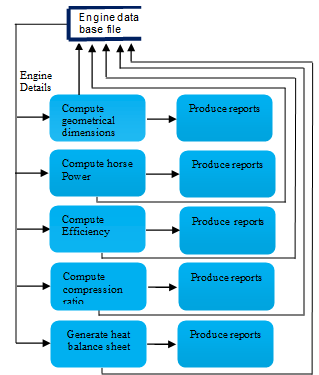
الشكل 2: مخطط تدفق البيانات لنظام معلومات المحرك
Copyrighted material, not to modify and reproduce the material
3.2.4. Compute compression ratio
Details of particular engine flows to process box "Compute compression ratio” compression ratio is computed as processed information is going to store in engine database file and to produce the report to "Produce reports" box See table 7.
3.2.5. Generate heat balance sheet
Details of particular engine flows to process box "Generate heat balance sheet" heat balance sheet is get generated as processed information is going to store in engine database file and to produce the report to "Produce reports” box. See table 1.
3.3. Geometrical dimensions
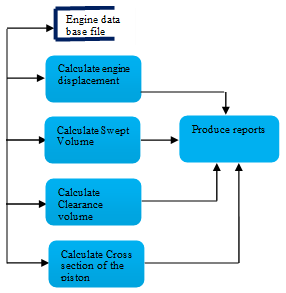
الشكل 3: مخطط تدفق البيانات للأبعاد الهندسية
Detail data flow diagram of process box of "Compute geometrical dimensions" of figure 2. From engine database file engine details of particular engine go to process boxes. Process boxes process the information as processed information is going to store in engine database file and to produce the report to "Produce reports” box. Shown in figure 3 and See table 3 & 4.
3.3.1. Engine Displacement
Details of particular engine go to “Calculate engine displacement " process box. Engine displacement is get calculated as processed information is going to store in engine database file and to produce the report to "Produce reports" box. Engine displacement has been defined as the total volume displaced by all the pistons as they move from their top dead center position. It determines the size of an engine in cubic centimeters (cc). This volume depends on the cylinder diameter (bore), piston stroke and the number of cylinder see equation 1.
π = 3.14
D = Diameter of the cylinder, cm (1)
L = Length of the stroke, cm
N = Number of cylinders
3.3.2. Swept Volume
Details of particular engine go to “Calculate swept volume” process box. Swept volume is get calculated as processed information is going to store in engine database fileandto produce the report to “Produce reports” box. Swept volume is calculated as see equation 2.
π= 3.14 (2)
D = Diameter of the cylinder
L= Length of stroke
3.3. 3 Cylinder Volume
Details of particular engine go to ”Calculate cylinder volume” process box. Cylinder volume is get calculated as processed information is going to store in engine database file and to produce the report to “Produce reports “box. See equation 3.
Cylinder volume=sweptvolume + clearenceevolume
(3)
3.3.4. Clearence Volume
Details of particular engine go to “Calculate clearance volume” process box. Clearance volume is get calculated as processed information is going to store in engine database file and to produce the report to “Produce reports” box. In the cylinder volume above the piston at top dead center is the clearance volume. Clearance volume is calculated as See equation 4.
π= 3.14 (4)
D= Diameter of the cylinder
H= Height from TDC to Cylinder head
3.3.5 Cross-section of the piston
Details of particular engine go to” Calculate cross section of the piston” process box. Cross section of the piston is get calculated as processed information is going to store in engine database file and to produce the report to “Produce reports” box. See equation 5.
π= 3.14 (5)
D=bore



Copyrighted material, not to modify and reproduce the material
3.4. Horse Power
Detail dataflow diagram of process box of “Compute horse power” of figure 2. From engine database file engine details of particular engine go to process boxes. Process boxes process the information as processed information is going to store in engine database file and to produce the report to "Produce reports" box. See figure 4.
3.4.1.Tax Horse power
Details of particular engine go to “Calculate tax horse power” process box. Tax horse power get calculated as processed information is going to store in engine data base file and to produce the report to “Produce reports” box. The RAC (Royal Automobile Club of England) horse power rating of engines is used to compare engines on the basis of the number and diameter of cylinders. This horse power rating is usually for tax purposes, and hence called taxablehorse Power. RAC horse power is given by. See equation 6.
D = diameter (or bore) of the cylinder (6)
N = number of cylinders
3.4.2.Indicated Horse power
Details of particular engine goto “Calculate indicated horse power" process box. Indicated horse power is get calculatedas processed information is going tostore in engine database file and to producethe report to “Produce reports" box. The power actually developed inside the engine cylinder by the combustion of fuel is called indicated horse power. Indicated horse power will be calculated for N number of cylinders If you enter number of cylinder 1 then it is getting calculated for 1 cylinder if you enter number of cylinders 4 then it will be calculated for 4 cylinders.See equation 7.
P = Mean effective pressure in kg/cm² (7)
L = Length of stroke
A = Area of piston in cm²
N = Number of RPM of crankshaft
Nc = Number of cylinders
3.4.3. Brake Horse Power
Details of particular engine go to “Calculate brake horse power” process box brake horse power is get calculated as processed information is going to store in engine data base file and to produce the report to “Produce reports “box. The power which the engine actually delivers to do the outside work is called brake horse power. It is the output power of an engine. It is usually 70 to 85% of its indicated horse power. It can be measured by some measuring instruments like prony brake or dynamometer and is given by the following relation. See equation 8.



π= 3.14
D= Diameter of the brake drum
N = Number of RPM of crank shaft (8)
F= Force registered on scale
S=Spring balance reading

Figure 4 Dataflow diagram of engine horse power
3.4.4 Friction horse power
Details of particular engine go to “Calculate Friction horse power” process box. Friction horse power is get calculated as processed information is going to store in engine data base file and to produce the report to “Produce reports” box. Friction horse power output power (or BHP) of an engine is always less than the input power (or IHP), because some power is lost in overcoming the friction between the moving parts. The power lost in friction in engine mechanism is called friction horse power. It is equal to the difference between the IHP and BHP. See equation 9.
FHP = IHP -- BHP (9)
3.5 Efficiency
Detail dataflow diagram of process box of “Compute efficiency” of figure2. From engine database file engine details of particular engine goes to process boxes. Process boxes process the information as processed information is going to store in engine database file and to produce the report to "Produce reports" box. See figure 5.
3.5.1. Mechanical efficiency
Details of particular engine go to “Calculate mechanical efficiency” process box. Mechanical efficiency is get calculated as processed information is going to store in engine data base file and to produce the report to “Produce reports” box
Mechanical efficiency is the ratio of brake horse power to indicated horse power. See equation 10.
(10)
3.5.2. Brake thermal efficiency
Details of particular engine go to “Calculate brake thermal efficiency" process box. Brake thermal efficiency is get calculated as processed information is going to store in engine database file and to produce the report to "Produce reports" box. It is the ratio of BHP or IHP to that heat energy of the fuel supplied during the same interval of time. Efficiency based on BHP is called Brake thermal efficiency. See equation 11.
W =Weight of cooling water supplied in kg/min (11)
Q = Lower calorific value in the fuel in kcal/kg
J = Mechanical equivalent of heat = 427

Copyrighted material, not to modify and reproduce the material
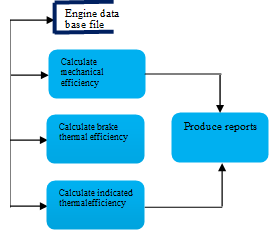
Figure 5 Data flow diagram of engine efficiency
3.5.3. Indicated thermal efficiency
Details of particular engine go to "Calculate indicated thermal efficiency” process box. Indicated thermal efficiency is get calculated as processed information is going to store in engine data base file and to produce the report to "Produce reports" box. It is the ratio of BHP or IHP to that heat energy of the fuel supplied during the same interval of time. Efficiency based on IHP is called Indicated thermal efficiency. See equation 12.
(12)
W =Weight of cooling water supplied in kg/min
Q = Lower calorific value in the fuel in kcal/kg
J = Mechanical equivalent of heat = 427
3.6 Compression ratio
Detail data flow diagram of process box of "Compute compression ratio" of figure2. From engine data base file engine details of particular engine go to process boxes. Process boxes process the information as processed information is going to store in engine database file and to produce the reports to “Produce reports box”.

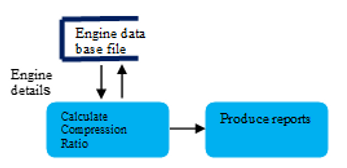
الشكل 6: مخطط تدفق البيانات لنسبة الضغط
تفاصيل محرك معين انتقل إلى "حساب نسبة الضغط" يتم حساب نسبة الضغط في مربع العملية حيث سيتم تخزين المعلومات المعالجة في ملف قاعدة بيانات المحرك وإنتاج التقرير في مربع "إصدار التقارير". انظر الشكل 6. إنها نسبة الشحنة في الاسطوانة فوق المكبس عند المركز الميت السفلي وحجم الشحنة عندما يكون المكبس في المركز الميت العلوي حيث أن الحجم فوق المكبس عند المركز الميت السفلي هو إزاحة الأسطوانة بالإضافة إلى حجم الخلوص والحجم أعلاه المكبس الموجود في أعلى المركز الميت هو حجم الخلوص، ويمكن تحديد نسبة الضغط كما هو موضح في المعادلة 13.
(13)
3.7 ميزان الحرارة
مخطط تدفق البيانات التفصيلي لمربع العملية "إنشاء ميزانية توازن الحرارة" في الشكل 2. من ملف قاعدة بيانات المحرك، تفاصيل المحرك لمحرك معين، انتقل إلى مربعات المعالجة. تقوم مربعات العمليات بمعالجة المعلومات حيث سيتم تخزين المعلومات المعالجة في ملف قاعدة بيانات المحرك وإصدار التقرير إلى مربع "إصدار التقارير".

Copyrighted material, not to modify and reproduce the material
تفاصيل محرك معين انتقل إلى مربع عملية "إنشاء ميزانية توازن الحرارة". يتم إنشاء الميزانية العمومية الحرارية حيث سيتم تخزين المعلومات المعالجة في ملف قاعدة بيانات المحرك وإنتاج التقرير في مربع "إنتاج الميزانية العمومية الحرارية". انظر الشكل 7.
3.7.1 توفير الحرارة
الحرارة الناتجة عن احتراق الوقود
وزن الوقود المزود بالكيلو جرام/دقيقة
القيمة الحرارية للوقود بالكيلو كالوري/كجم
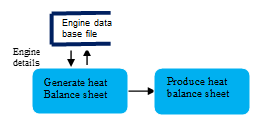
Figure 7 Data Flow diagram of heat balance sheet
3.7.2 Heat to IHP
Heat converted to IHP
3.7.3 Heat to cooling water
Heat carried away by cooling water. See equation 14.

Ww = weight of cooling water supplied in kg/min
t1 = temperature of cooling water at outlet in °C
t2 =temperature of water at inlet in°C
3.7.4 Heat to exhaust gas
Heat carried away by exhaust gases can be determined by the exhaust gas calorimeter. See equation 15.
Heat taken away by the water from the
exhaust gases =
(15)
Q = lower calorific value in the fuel in kcal/kg
Ww = weight of water flowing in kg /min
Tw2 = Temperature of water at outlet in °C
Tw1 = Temperature of water at inlet in °C
Table 1 Heat balance sheet
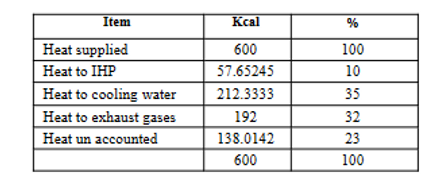
التقارير 4
4.1 تقرير المحرك الواحد
سيتم عرض تقرير عن كل محرك خاص بتقرير رقم المحرك في صفحة واحدة يتضمن التقرير الأبعاد الهندسية والقدرة الحصانية والكفاءة وميزان الحرارة.

4.2 تقرير الأبعاد الهندسية للمحرك لمحركات متعددة
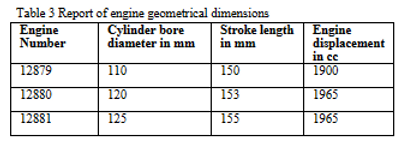
بناءً على تقرير رقم المحرك، سيتم عرضه لمحركات متعددة بتنسيق الصف والعمود. يتضمن التقرير
رقم المحرك وقطر تجويف الأسطوانة وطول الشوط وإزاحة المحرك.
4.2.1 تقرير الأبعاد الهندسية للمحرك لمحركات متعددة.

Copyrighted material, not to modify and reproduce the material
بناءً على تقرير رقم المحرك، سيتم عرضه لمحركات متعددة بتنسيق الصف والعمود. يتضمن التقرير رقم المحرك وحجم المسح وحجم الخلوص وحجم الأسطوانة والمقطع العرضي للمكبس.
4.2.2. تقرير قوة حصان المحرك لمحركات متعددة
بناءً على تقرير رقم المحرك، سيتم عرضه لمحركات متعددة بتنسيق الصف والعمود. يتضمن التقرير رقم المحرك وعدد الأشواط وعدد الدورات في الدقيقة والقدرة الحصانية الضريبية وقوة الحصان المشار إليها وقوة حصان الفرامل وقوة حصان الاحتكاك.
الجدول 5: تقرير القدرة الحصانية للمحرك لمحركات متعددة
4.2.4 تقرير نسبة ضغط المحرك لمحركات متعددة
الجدول 7: تقرير نسبة الضغط لمحركات متعددة

بناءً على تقرير رقم المحرك، سيتم عرضه لمحركات متعددة بتنسيق الصف والعمود. يتضمن التقرير رقم المحرك وحجم التخليص وحجم الأسطوانة ونسبة الضغط.
Copyrighted material, not to modify and reproduce the material
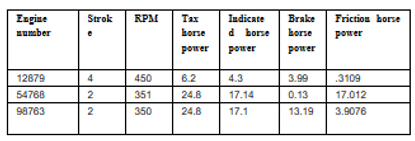
4.2.3 تقرير كفاءة المحرك لمحركات متعددة
الجدول 6: تقرير كفاءة المحرك لمحركات متعددة
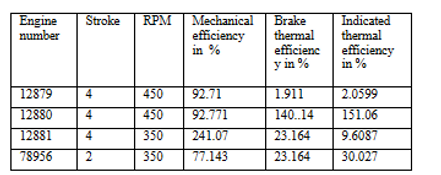
بناءً على تقرير رقم المحرك، سيتم عرضه لمحركات متعددة بتنسيق الصف والعمود. يتضمن التقرير رقم المحرك وعدد الأشواط وعدد الدورات في الدقيقة والكفاءة الميكانيكية والكفاءة الحرارية للفواصل والكفاءة الحرارية المشار إليها.
